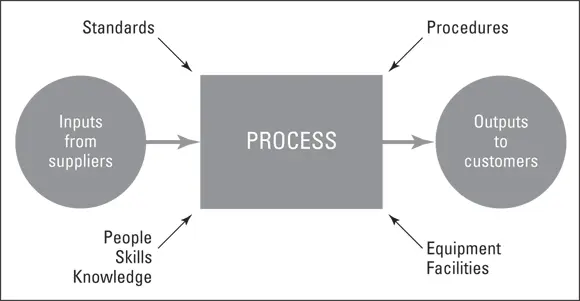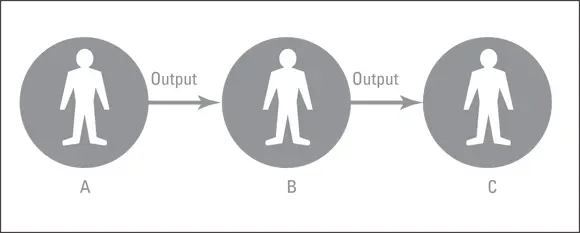Understanding the Process Basics
A process is a series of steps and actions that produce an output in the form of a product or service. Ideally, each process should add value in the eyes of the customer.
All work is a process, and a process is a blend of PEMME:
P eople: Those working in or around the process. Do you have the right number of people in the right place, at the right time and possessing the right skills for the job? And do they feel supported and motivated?
E quipment: The various items needed for the work. Items can be as simple as a stapler or as complicated as a lathe used in manufacturing. Consider whether you have the right equipment, located in an appropriate and convenient place, and being properly maintained and serviced.
M ethod: How the work gets done — the process steps, procedures, tasks and activities involved.
M aterials: The things necessary to do the work — for example, the raw materials needed to make a product or the information needed to provide a service.
E nvironment: The working area — perhaps a room or surface needs to be dust-free, or room temperature must be within defined parameters.
Focusing on PEMME helps you think differently when considering what a process actually is. (All the elements of PEMME also combine to influence the results from your processes in relation to variation — as covered in Chapter 8.)
Pinpointing the elements of a process
The concept of processes and PEMME applies to everything you do, from getting up in the morning, to making a cup of tea, to placing an online order. All of these activities can be broken down into a series of steps. The process model shown in Figure 3-1 has PEMME at its heart (the “process”), but it also builds on PEMME and helps you think about the wider requirements of the process. To meet your customers’ requirements (the CTQs (Critical to Quality) covered in Chapters 2and 4), the process elements must be addressed.

© Martin Brenig-Jones and Jo Dowdall
FIGURE 3-1:Using a process model.
Ensuring that the CTQs are understood and agreed on is the first requirement of a process. More often than not, a lack of quality or rework is the direct result of not understanding or defining the customer’s requirements properly. Even for apparently simple things, a little extra time spent in translating the voice of the customer and clarifying requirements can help save time and potential upset later on. Once the customer’s requirements have been agreed, determining your own requirements from suppliers is the next step. Now you’re the customer, so spend time with your suppliers to ensure your needs are properly understood and agreed.
Make sure you have the right number of people working in the process, and that they have the necessary knowledge and skills. If they don’t, appropriate training needs to be delivered.
You’ll need to document the process (or procedures) too. Documented processes (whether in the form of words, pictures, or videos) should describe precisely how the work gets done — the method — and must be developed, agreed, appropriately documented, and kept up to date, especially in a culture of Continuous Improvement, where enhancements are regularly being made to the process. Importantly, they should be simple to follow and understand.
Properly describing relevant standards is also sensible. They may well form part of the method, applying, for example, to regulatory requirements or service-level agreements that need to be followed. Like procedures, the standards should be documented in an easily accessible manner. Similarly, if budget constraints or authority limits on certain actions apply, management must ensure the people in the process know the details.
Equipment and facilities are needed to operate the process, and need to be capable of meeting or exceeding the customer requirements. These must be appropriate from day one, located in the right place and correctly maintained thereafter. Also ensure the environment is appropriate for the activity. The facilities link to the environment element of PEMME and could include having the right workspace, for example.
Identifying internal and external customers
All of your processes are likely to involve other people. There will be people involved in the different steps of the process. They may be members of your team or department, but could also be in other departments or functions. There will also be people who provide the inputs you need to start the work — for example, information, perhaps a schedule of available products, or an approved order. These are your suppliers. There will be people who receive the outputs of your process. These are your customers. Suppliers and customers could be internal (from inside your organization) or external (from outside your organization), or both!
Knowing who the internal customers and suppliers are, and how they fit into the picture, is important because together they form the end-to-end process, the value stream that ultimately provides the external customer with the service or product they’re looking for.
Consider Figure 3-2. Department A produces output for Department B, which produces output for Department C, which provides the answer to an external customer enquiry. Each of these departments is involved in the process and needs to understand the objectives of the “big process” or overall system.

© Martin Brenig-Jones and Jo Dowdall
FIGURE 3-2:Identifying your internal customers.
All too often, departments work in a vacuum, doing their own thing without regard for its impact on the end-to-end process. They may have their own targets, measures and priorities, for example. Possibly, the end-to-end process or value stream isn’t even known; each team or department involved works as though their step in the process is independent of any others. In reality, the end-to-end process is a series of interdependent steps, and the overall system is made up of a series of processes.
Internal customers and suppliers must understand their relationship and how their different roles contribute to “the bigger picture.” If they don’t, the external customers will receive poor service or product — the very people who should be viewed as the most important because they’re paying the organization for the services or products they provide.
Even if you’re not directly dealing with the external customer, you’re quite likely to be dealing with someone who is. So, understanding the bigger picture is important, and meeting the requirements of your internal customers could well be the key to successfully meeting the external customers’ CTQs. Quality Function Deployment (QFD) is helpful here. QFD establishes a clear link between each process requirement and the end customer, making it easier for each employee to see the role that they play in meeting customer requirements. We cover QFD in Chapter 14.
Getting a High-Level Picture
To really understand how the work gets done, and to identify just who the internal and external customers are, you need to draw a picture of the process. These pictures are known as process or Value Stream Maps (covered in detail in Chapter 5). Avoid going into fine detail at this stage, as too much information can be distracting. Keep it simple and “high level.”
Читать дальше














